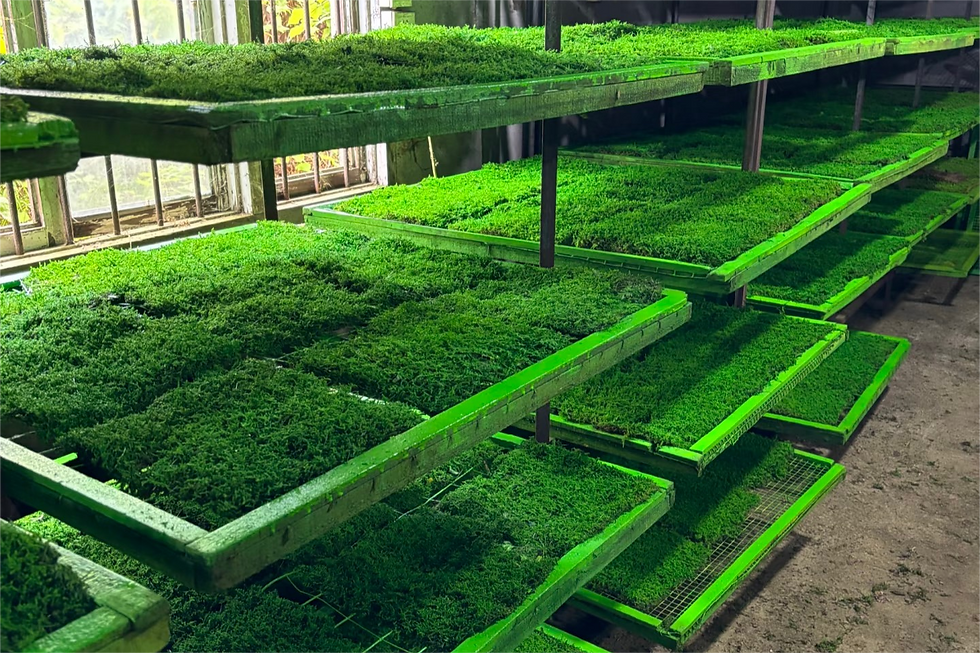Artificial & Fake Moss vs. Preserved Moss: What’s the Real Difference?
- Annie Zhang

- Oct 7
- 4 min read

If you are planning a large project—a green wall in a shopping mall, a feature ceiling in a hotel lobby, or an office interior with natural accents—you’ve probably run into the same dilemma: Should you choose artificial moss or preserved moss? At first glance they might look similar, but their performance, cost, and long-term value are very different. Making the wrong choice can lead to fading colors, higher maintenance costs, or even safety compliance issues.
In this article, I’ll break down what artificial (fake) moss and preserved moss really are, their strengths and weaknesses, and how to decide which one best fits your project.
Index:
👉 Unsure which option fits your project? Email us at sales@sweetie-group.com with your site conditions, and we can recommend the most suitable solution.
What Is Artificial (Fake) Moss?
Artificial moss is entirely man-made. It’s usually crafted from plastics, fibers, or polyurethane foams to mimic the look of real moss. Depending on the quality, it can appear quite convincing from a distance. Some higher-end versions include UV stabilizers or even fire retardant coatings to meet building codes.
Main features of artificial moss:
Manufactured to be uniform in texture and color.
Can be designed to resist UV light or fire, depending on product grade.
Works well in places where real or preserved moss would quickly deteriorate, such as outdoor facades or areas with constant direct sunlight.
Requires almost no ongoing maintenance—just occasional dusting.
Artificial moss is often chosen for temporary displays, outdoor signage, or projects where durability and low upkeep are more important than natural authenticity.

What Is Preserved Moss?
Preserved moss starts out as real, living moss. After harvesting, it is carefully treated—typically with glycerin or other safe, food-grade solutions—to replace the natural sap and water in the plant. The result is moss that looks and feels natural but no longer grows.
Key advantages of preserved moss:
100% natural texture and softness that artificial products can’t fully replicate.
Vibrant colors achieved through safe dyes, which last for years in indoor environments.
No need for soil, watering, or sunlight.
More eco-friendly than synthetic alternatives, as it’s biodegradable and harvested responsibly.
Because preserved moss keeps its authentic appearance without the need for live-plant care, it’s a favorite in upscale interiors where aesthetics matter.
👉 If you’d like samples of preserved moss, contact us at sales@sweetie-group.com and we’ll be glad to provide them.

Artificial vs. Preserved Moss: Key Differences at a Glance
Here’s a simple comparison to help you see where each option stands:
Pros and Cons of Artificial Moss
Pros:
Very durable, especially outdoors.
Lower upfront material and installation costs.
Almost zero maintenance.
Easy to source in bulk with consistent look.
Cons:
May appear less authentic, especially under close inspection.
Made from plastics, less eco-friendly.
Cheap versions can fade quickly or look obviously fake.
If durability is your top priority and the project site is exposed to harsh conditions, artificial moss might be your safest option.
Pros and Cons of Preserved Moss
Pros:
Real moss look and feel; premium visual quality.
Environmentally friendly with responsible harvesting.
Long lifespan indoors (10+ years under stable conditions).
Enhances the “natural luxury” feel of a space.
Cons:
Higher upfront cost.
Not ideal for outdoor use or spaces with strong direct sunlight.
Needs some care—avoid excess humidity or handling.
Preserved moss is ideal for corporate lobbies, restaurants, offices, and retail interiors where people will be close enough to appreciate its authenticity.
👉 If you’d like samples of preserved moss for side-by-side comparison, contact us at sales@sweetie-group.com and we’ll be glad to provide them.
How to Choose the Right Moss for Your Project
The decision really comes down to context:
Indoor feature walls with controlled light and humidity → Preserved moss is the better choice for authenticity and long-term value.
Outdoor facades, signage, or areas exposed to heavy traffic → Artificial moss will hold up better against weather and handling.
Temporary events or trade shows → Artificial moss is cost-effective and durable for reuse.
Premium interior projects where texture and luxury matter → Preserved moss justifies the investment.
Common Misconceptions You Should Avoid
“Preserved moss is fake moss.”Not true. Preserved moss is real moss that has been treated. Artificial moss, by contrast, is entirely synthetic.
“Preserved moss is maintenance-free in all conditions.”While it doesn’t need water or soil, direct sunlight or high humidity can cause fading or mold.
“Artificial moss is always cheaper in the long run.”A low-quality artificial installation that fades or cracks may need replacement sooner, making it more costly over time than preserved moss.
Being clear about these differences helps you avoid budget overruns and performance disappointments.
Final Recommendation
Both artificial and preserved moss have their place in commercial design. Artificial moss shines where durability and low cost matter most, such as outdoor or temporary setups. Preserved moss delivers the best return when authenticity and long-lasting beauty are the priority, especially in premium interiors.
If you’re sourcing for a project, don’t stop at pictures—always test samples under your own site lighting, and request documentation for fire ratings and certifications.
👉 To discuss bulk purchasing, request certifications, or schedule a consultation, write to us at sales@sweetie-group.com. We’ll help you find the best option for your needs.

CEO of Sweetie-Group









Comments